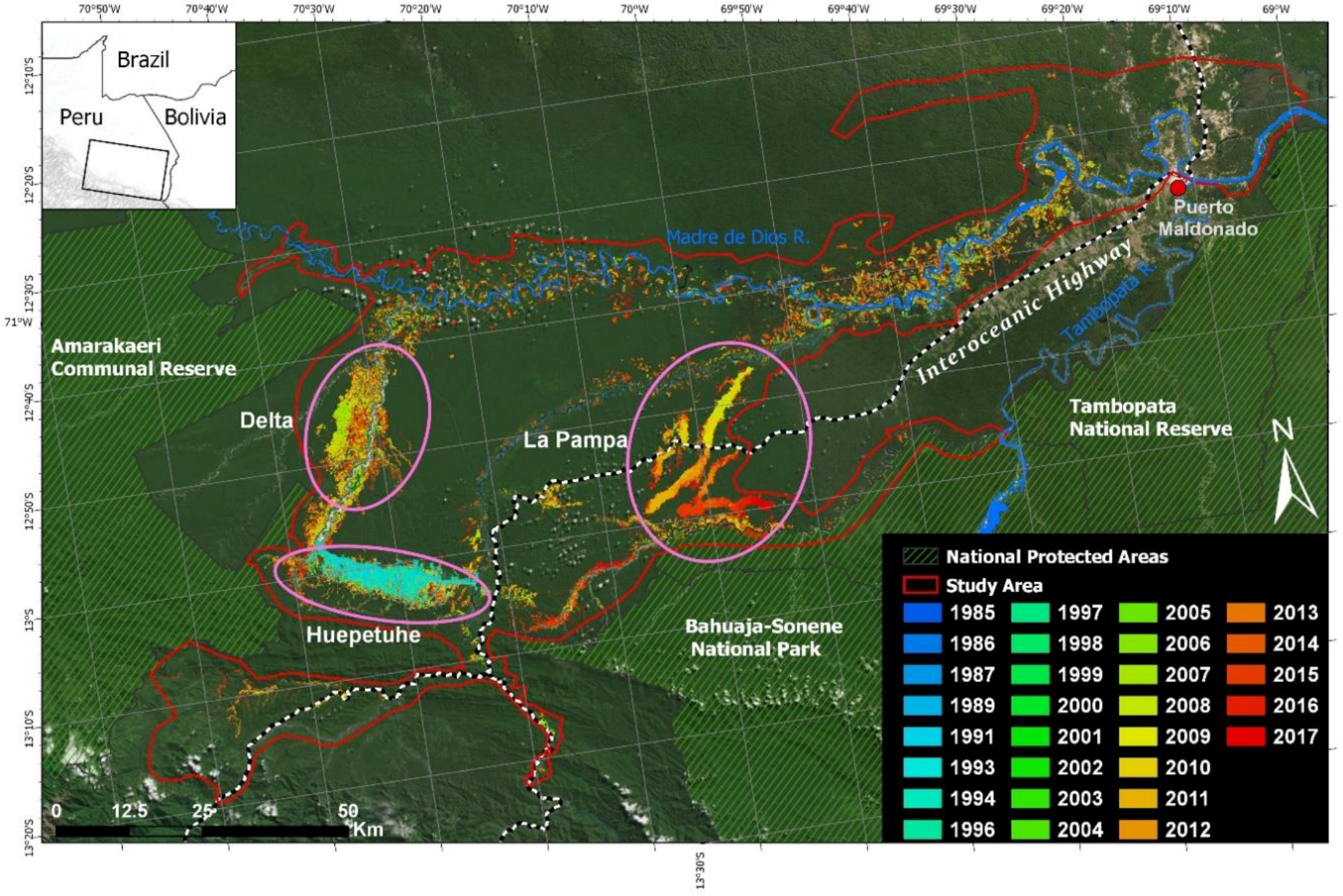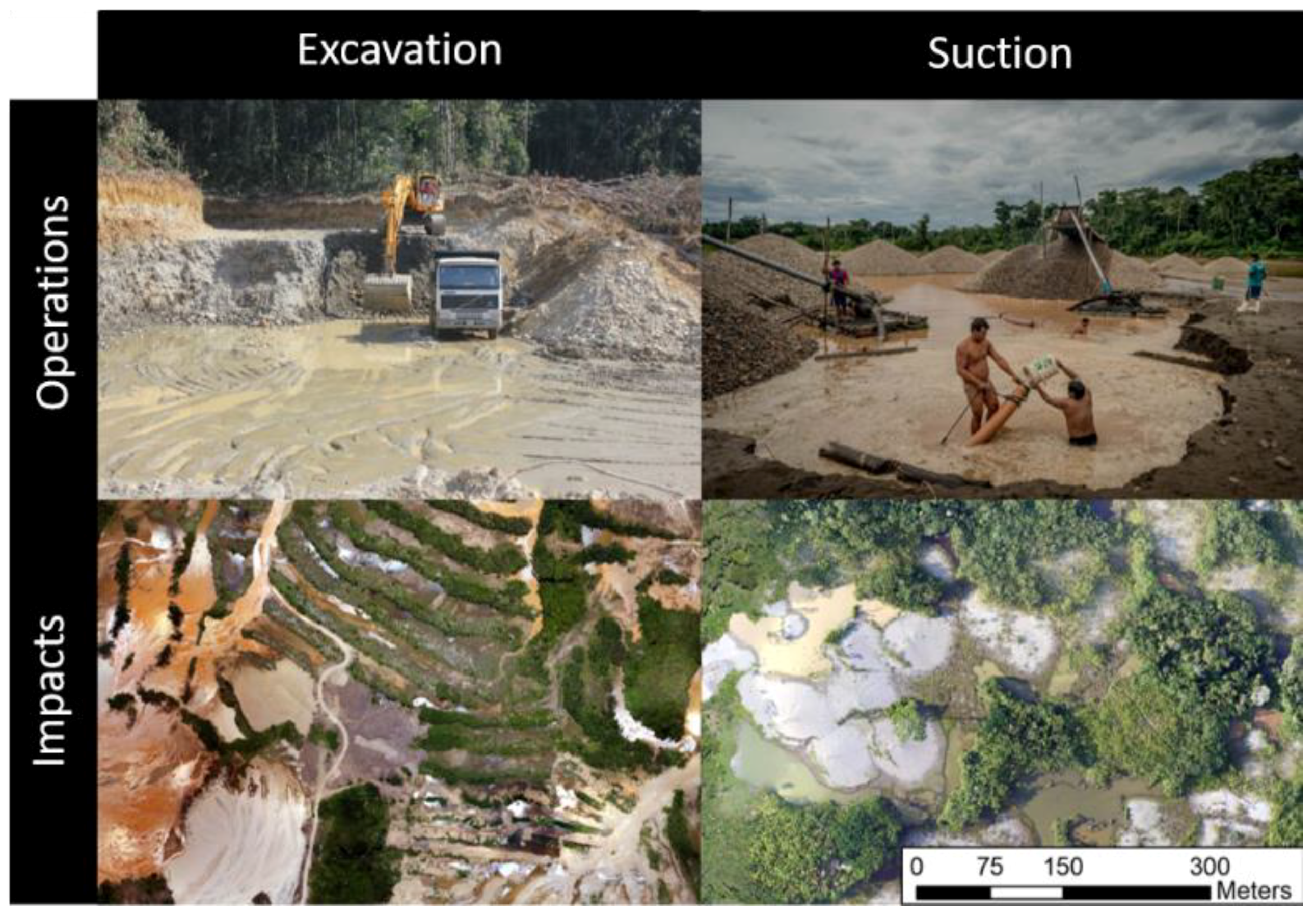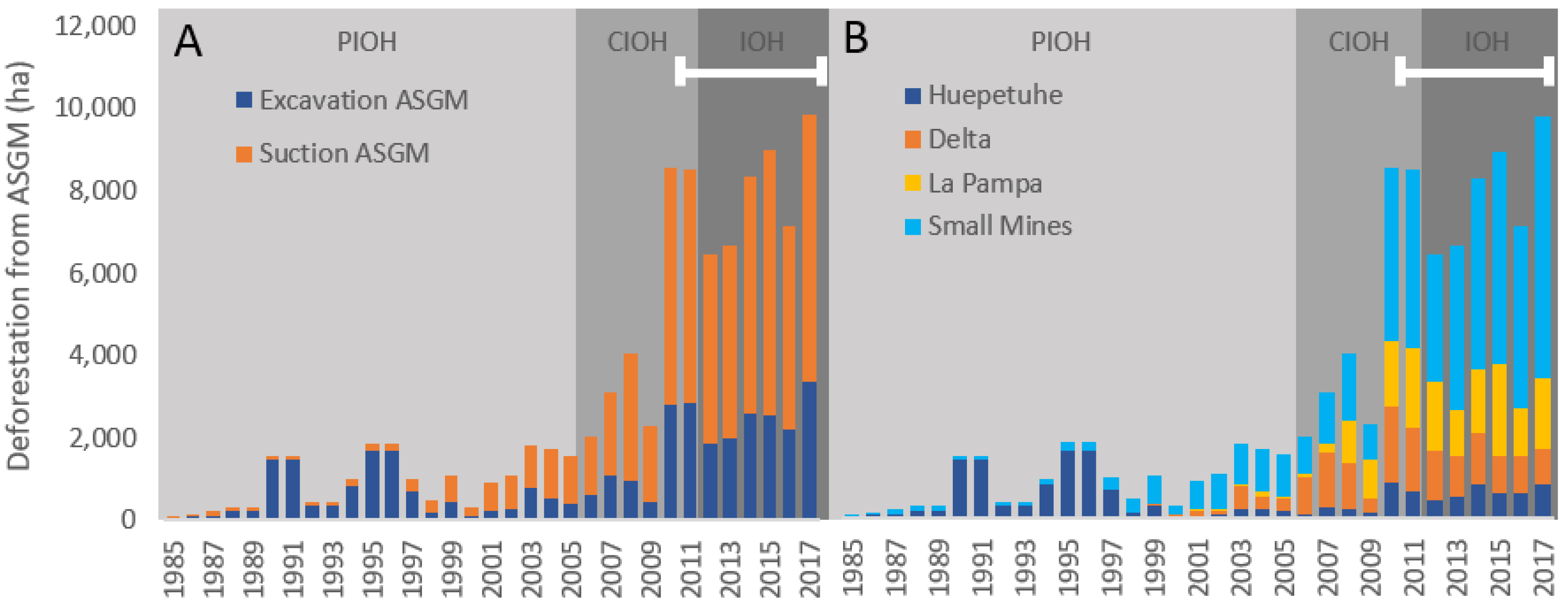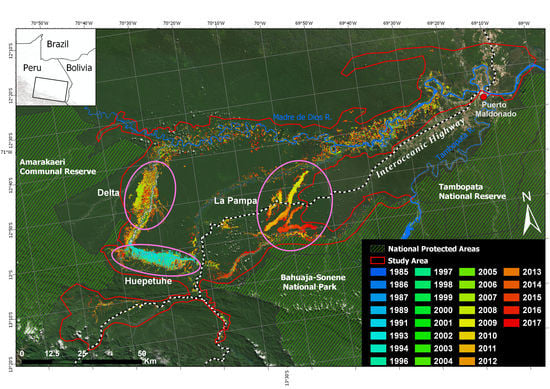Deforestation and Forest Degradation Due to Gold Mining in the Peruvian Amazon: A 34-Year Perspective
Abstract
1. Introduction
2. Materials and Methods
2.1. Study Area
2.2. Satellite Image Processing and Mining Detection
2.3. Gold Mining Type Classification
2.4. Analysis of Economic Drivers
2.5. Validation
3. Results
3.1. Historical Deforestation from Gold Mining
3.2. Underestimation of Mining Extent Using CLASlite
3.3. Deforestation, Gold Price, and the Interoceanic Highway
3.4. A Turn toward Small Mines
3.5. Significant Differences in ASGM Techniques
3.6. Mining and Total Deforestation
4. Discussion
4.1. Interdiction
4.2. Economic Drivers of Mining Expansion
4.3. Protected Areas and the Mining Corridor
4.4. The Significance of Mining Methods
4.5. Dark Mining
4.6. Difficulty in Accurately Classifying ASGM
4.7. Classification Error
5. Conclusions
Supplementary Materials
Author Contributions
Funding
Acknowledgments
Conflicts of Interest
References
- Van der Werf, G.R.; Morton, D.C.; DeFries, R.S.; Olivier, J.G.; Kasibhatla, P.S.; Jackson, R.B.; Collatz, G.J.; Randerson, J.T. Werf CO2 emissions from forest loss. Nat. Geosci. 2009, 2, 737–738. [Google Scholar] [CrossRef]
- Achard, F.; Beuchle, R.; Mayaux, P.; Stibig, H.-J.; Bodart, C.; Brink, A.; Carboni, S.; Desclée, B.; Donnay, F.; Eva, H.D.; et al. Determination of tropical deforestation rates and related carbon losses from 1990 to 2010. Glob. Chang. Biol. 2014, 20, 2540–2554. [Google Scholar] [CrossRef] [PubMed]
- Potapov, P.; Hansen, M.C.; Laestadius, L.; Turubanova, S.; Yaroshenko, A.; Thies, C.; Smith, W.; Zhuravleva, I.; Komarova, A.; Minnemeyer, S.; et al. The last frontiers of wilderness: Tracking loss of intact forest landscapes from 2000 to 2013. Sci. Adv. 2017, 3, e1600821. [Google Scholar] [CrossRef] [PubMed]
- Song, X.-P.; Hansen, M.C.; Stehman, S.V.; Potapov, P.V.; Tyukavina, A.; Vermote, E.F.; Townshend, J.R. Global land change from 1982 to 2016. Nature 2018, 560, 639–643. [Google Scholar] [CrossRef] [PubMed]
- Finer, M.; Novoa, S. MAAP Synthesis # 1: Patterns and Drivers of Deforestation in the Peruvian Amazon; ACCA: Lima, Peru, 2015. [Google Scholar]
- Román-Dañobeytia, F.; Huayllani, M.; Michi, A.; Ibarra, F.; Loayza-Muro, R.; Vázquez, T.; Rodríguez, L.; García, M. Reforestation with four native tree species after abandoned gold mining in the Peruvian Amazon. Ecol. Eng. 2015, 85, 39–46. [Google Scholar] [CrossRef]
- Peres, C.A. Synergistic effects of subsistence hunting and habitat fragmentation on amazonian forest vertebrates. Conserv. Biol. 2001, 15, 1490–1505. [Google Scholar] [CrossRef]
- Ashe, K. Elevated mercury concentrations in humans of Madre de Dios, Peru. PLoS ONE 2012, 7, e33305. [Google Scholar] [CrossRef] [PubMed]
- Seccatore, J.; Veiga, M.; Origliasso, C.; Marin, T.; De Tomi, G. An estimation of the artisanal small-scale production of gold in the world. Sci. Total Environ. 2014, 496, 662–667. [Google Scholar] [CrossRef] [PubMed]
- Swenson, J.J.; Carter, C.E.; Domec, J.-C.; Delgado, C.I. Gold mining in the Peruvian Amazon: Global prices, deforestation, and mercury imports. PLoS ONE 2011, 6, e18875. [Google Scholar] [CrossRef] [PubMed]
- Van Dijck, P.; Van Barneveld, B. The Impact of the IIRSA Road Infrastructure Programme on Amazonia; Routledge: Abingdon, UK, 2013; ISBN 9780415531085. [Google Scholar]
- McSweeney, K.; Richani, N.; Pearson, Z.; Devine, J.; Wrathall, D.J. Why Do Narcos Invest in Rural Land? J. Lat. Am. Geogr. 2017, 16, 3–29. [Google Scholar] [CrossRef]
- Baccini, A.; Goetz, S.; Walker, W. Estimated carbon dioxide emissions from tropical deforestation improved by carbon-density maps. Nat. Clim. Chang. 2012, 2, 182–185. [Google Scholar] [CrossRef]
- Asner, G.P.; Knapp, D.E.; Martin, R.E.; Tupayachi, R.; Anderson, C.B.; Mascaro, J.; Sinca, F.; Chadwick, K.D.; Higgins, M.; Farfan, W.; et al. Targeted carbon conservation at national scales with high-resolution monitoring. Proc. Natl. Acad. Sci. USA 2014, 111, E5016–E5022. [Google Scholar] [CrossRef] [PubMed]
- Asner, G.P. Tropical forest carbon assessment: Integrating satellite and airborne mapping approaches. Environ. Res. Lett. 2009, 4, 034009. [Google Scholar] [CrossRef]
- Asner, G.P. Automated mapping of tropical deforestation and forest degradation: CLASlite. J. Appl. Remote Sens. 2009, 3, 033543. [Google Scholar] [CrossRef]
- Hansen, M.C.; Potapov, P.V.; Moore, R.; Hancher, M.; Turubanova, S.A.; Tyukavina, A.; Thau, D.; Stehman, S.V.; Goetz, S.J.; Loveland, T.R.; et al. High-resolution global maps of 21st-century forest cover change. Science 2013, 342, 850–853. [Google Scholar] [CrossRef] [PubMed]
- Asner, G.P.; Tupayachi, R. Accelerated losses of protected forests from gold mining in the Peruvian Amazon. Environ. Res. Lett. 2017, 12, 094004. [Google Scholar] [CrossRef]
- Asner, G.P.; Llactayo, W.; Tupayachi, R.; Luna, E.R. Elevated rates of gold mining in the Amazon revealed through high-resolution monitoring. Proc. Natl. Acad. Sci. USA 2013, 110, 18454–18459. [Google Scholar] [CrossRef] [PubMed]
- Asner, G.P. Carnegie Institution for Science. Personal communication, 2018. [Google Scholar]
- Lobo, F.D.L.; Costa, M.; Novo, E.M.L.D.M.; Telmer, K. Distribution of Artisanal and Small-Scale Gold Mining in the Tapajós River Basin (Brazilian Amazon) over the Past 40 Years and Relationship with Water Siltation. Remote Sens. 2016, 8, 579. [Google Scholar] [CrossRef]
- INEI—3.4.2 La Migración en las Ciudades de la Región Sur. Available online: https://www.inei.gob.pe/media/MenuRecursivo/publicaciones_digitales/Est/Lib0018/cap34002.htm (accessed on 28 August 2018).
- Población 2000 al 2015. Available online: https://proyectos.inei.gob.pe/web/poblacion/ (accessed on 28 August 2018).
- ESRI. ArcGIS Pro, (version 2.2) Windows; ESRI: Redlands, CA, USA, 2018. [Google Scholar]
- INGEMET. Mapa Geomorphologico del Perú; INGEMET: Lima, Peru, 2000.
- Digital Globe. Imagery. 2018. Available online: https://evwhs.digitalglobe.com (accessed on 17 September 2018).
- Planet Team. Planet Application Program Interface: In Space for Life on Earth; Windows; Planet Team: Lilongwe, Malawi, 2018. [Google Scholar]
- Román-Dañobeytia, F. Centro de Innovación Científica de la Amazónica. Personal communication, 2018. [Google Scholar]
- The Authority on Gold | World Gold Council. Available online: https://www.gold.org/ (accessed on 11 January 2018).
- Moore, T. La deforestación en Madre de Dios y sus implicancias para los pueblos originarios. In Deforestación en Tiempos de Cambio Climático; Chirif, A., Ed.; IWGIA: Lima, Peru, 2018; pp. 195–222. ISBN 978-87-92786-84-5. [Google Scholar]
- SAS Institute Inc. JMP, (version 13) Windows; SAS Institute Inc.: Cary, NC, USA, 2016. [Google Scholar]
- Lillesand, T.S.; Kiefer, R.W.; Chipman, J.W. Remote Sensing and Image Interpretation, 7th ed.; John Wiley & Sons: Hoboken, NJ, USA, 2008; ISBN 1088765432. [Google Scholar]
- Flores, M.C. Realizan Interdicción de Minería Ilegal en río Malinowski | El Comercio | Perú | Madre De Dios | El Comercio Perú. Available online: https://elcomercio.pe/peru/madre-de-dios/realizan-interdiccion-mineria-ilegal-rio-malinowski-noticia-469525 (accessed on 28 August 2018).
- Calvo, L.F. Minería Ilegal: 62 Megaoperaciones de Interdicción en el 2015 | El Comercio | Perú | El Comercio Perú. Available online: https://elcomercio.pe/peru/mineria-ilegal-62-megaoperaciones-interdiccion-2015-165913 (accessed on 28 August 2018).
- Marina de Guerra del Perú | Interdicciones Contra la Minería Ilegal en el río Malinowski | Noticias Navales. Available online: https://www.marina.mil.pe/es/noticia/interdicciones-contra-la-mineria-ilegal-en-el-rio-malinowski-1/ (accessed on 28 August 2018).
- Galaz, V.; Gars, J.; Moberg, F.; Nykvist, B.; Repinski, C. Why Ecologists Should Care about Financial Markets. Trends Ecol. Evol. 2015, 30, 571–580. [Google Scholar] [CrossRef] [PubMed]
- Reitano, T. Organized Crime as a Threat to Sustainable Development: Understanding the Evidence. In Organized Crime and Illicit Trade; Springer International Publishing: Cham, Switzerland, 2018; pp. 23–35. [Google Scholar]
- Daley, S. Peru Scrambles to Drive Out Illegal Gold Mining and Save Precious Land—The New York Times. Available online: https://www.nytimes.com/2016/07/26/world/americas/peru-illegal-gold-mining-latin-america.html?_r=0&ref=nyt-es&mcid=nyt-es&subid=article (accessed on 28 August 2018).
- Reserva Nacional de Tambopata es Gravemente Afectada por la Minería Ilegal—America Noticias. Available online: https://www.americatv.com.pe/noticias/actualidad/reserva-nacional-tambopata-gravemente-afectada-mineria-ilegal-n262381 (accessed on 28 August 2018).
- Pighi-Bel, P. Tambopata: La Reserva Natural de Perú que Empieza a Convertirse en un Desierto—BBC News Mundo. Available online: https://www.bbc.com/mundo/noticias-america-latina-37562790 (accessed on 28 August 2018).
- Vuohelainen, A.J.; Coad, L.; Marthews, T.R.; Malhi, Y.; Killeen, T.J. The effectiveness of contrasting protected areas in preventing deforestation in Madre de Dios, Peru. Environ. Manag. 2012, 50, 645–663. [Google Scholar] [CrossRef] [PubMed]
- Nolte, C.; Agrawal, A.; Silvius, K.M.; Soares-Filho, B.S. Governance regime and location influence avoided deforestation success of protected areas in the Brazilian Amazon. Proc. Natl. Acad. Sci. USA 2013, 110, 4956–4961. [Google Scholar] [CrossRef] [PubMed]
- Finer, M.; Novoa, S.; Olexy, T. MAAP #61: Illegal Gold Mining Decreases in Tambopata National Reserve | MAAP. Available online: http://maaproject.org/2017/tambopata_decrease/ (accessed on 31 July 2018).
- Cabanillas Vásquez, F. Manual de Buenas Prácticas en Minería Aurífera Aluvial Para Facilitar una Adecuada Recuperación de Áreas; Ministerio del Ambiente: Lima, Peru, 2016. [Google Scholar]
- Janovec, J.P. Evaluación de los Actuales Impactos y Amenazas Inminentes en Aguajales y Cochas de Madre de Dios; World Wildlife Fund Inc.: Lima, Peru, 2013. [Google Scholar]
- Wyatt, J.L.; Silman, M.R. Distance-dependence in two Amazonian palms: Effects of spatial and temporal variation in seed predator communities. Oecologia 2004, 140, 26–35. [Google Scholar] [CrossRef] [PubMed]
- Terborgh, J.; Nuñez-Iturri, G.; Pitman, N.C.A.; Valverde, F.H.C.; Alvarez, P.; Swamy, V.; Pringle, E.G.; Paine, C.E.T. Tree recruitment in an empty forest. Ecology 2008, 89, 1757–1768. [Google Scholar] [CrossRef] [PubMed]
- Martinez, G.; McCord, S.; Driscoll, C.; Todorova, S.; Wu, S.; Araújo, J.; Vega, C.; Fernandez, L. Mercury Contamination in Riverine Sediments and Fish Associated with Artisanal and Small-Scale Gold Mining in Madre de Dios, Peru. Int. J. Environ. Res. Public Health 2018, 15, 1584. [Google Scholar] [CrossRef] [PubMed]
- Zhang, L.; Zhang, L.; Du, B. Deep Learning for Remote Sensing Data: A Technical Tutorial on the State of the Art. IEEE Geosci. Remote Sens. Mag. 2016, 4, 22–40. [Google Scholar] [CrossRef]
- Blaschke, T. Object based image analysis for remote sensing. 5ISPRS6 J. Photogramm. Remote Sens. 2010, 65, 2–16. [Google Scholar] [CrossRef]
- Blaschke, T.; Hay, G.J.; Kelly, M.; Lang, S.; Hofmann, P.; Addink, E.; Queiroz Feitosa, R.; van der Meer, F.; van der Werff, H.; van Coillie, F.; et al. Geographic Object-Based Image Analysis—Towards a new paradigm. ISPRS J. Photogramm. Remote Sens. 2014, 87, 180–191. [Google Scholar] [CrossRef] [PubMed]







© 2018 by the authors. Licensee MDPI, Basel, Switzerland. This article is an open access article distributed under the terms and conditions of the Creative Commons Attribution (CC BY) license (http://creativecommons.org/licenses/by/4.0/).
Share and Cite
Caballero Espejo, J.; Messinger, M.; Román-Dañobeytia, F.; Ascorra, C.; Fernandez, L.E.; Silman, M. Deforestation and Forest Degradation Due to Gold Mining in the Peruvian Amazon: A 34-Year Perspective. Remote Sens. 2018, 10, 1903. https://doi.org/10.3390/rs10121903
Caballero Espejo J, Messinger M, Román-Dañobeytia F, Ascorra C, Fernandez LE, Silman M. Deforestation and Forest Degradation Due to Gold Mining in the Peruvian Amazon: A 34-Year Perspective. Remote Sensing. 2018; 10(12):1903. https://doi.org/10.3390/rs10121903
Chicago/Turabian StyleCaballero Espejo, Jorge, Max Messinger, Francisco Román-Dañobeytia, Cesar Ascorra, Luis E. Fernandez, and Miles Silman. 2018. "Deforestation and Forest Degradation Due to Gold Mining in the Peruvian Amazon: A 34-Year Perspective" Remote Sensing 10, no. 12: 1903. https://doi.org/10.3390/rs10121903
APA StyleCaballero Espejo, J., Messinger, M., Román-Dañobeytia, F., Ascorra, C., Fernandez, L. E., & Silman, M. (2018). Deforestation and Forest Degradation Due to Gold Mining in the Peruvian Amazon: A 34-Year Perspective. Remote Sensing, 10(12), 1903. https://doi.org/10.3390/rs10121903





